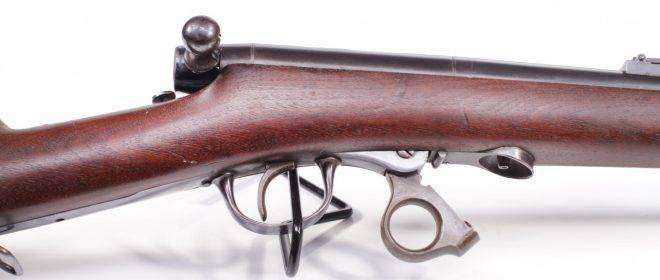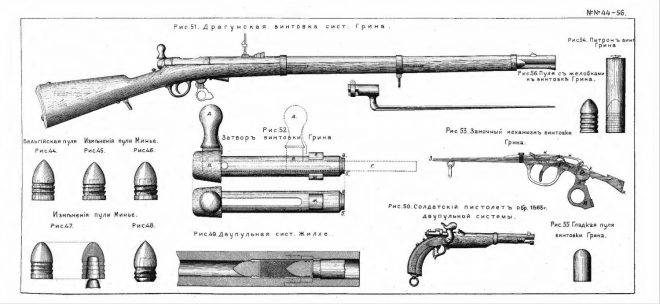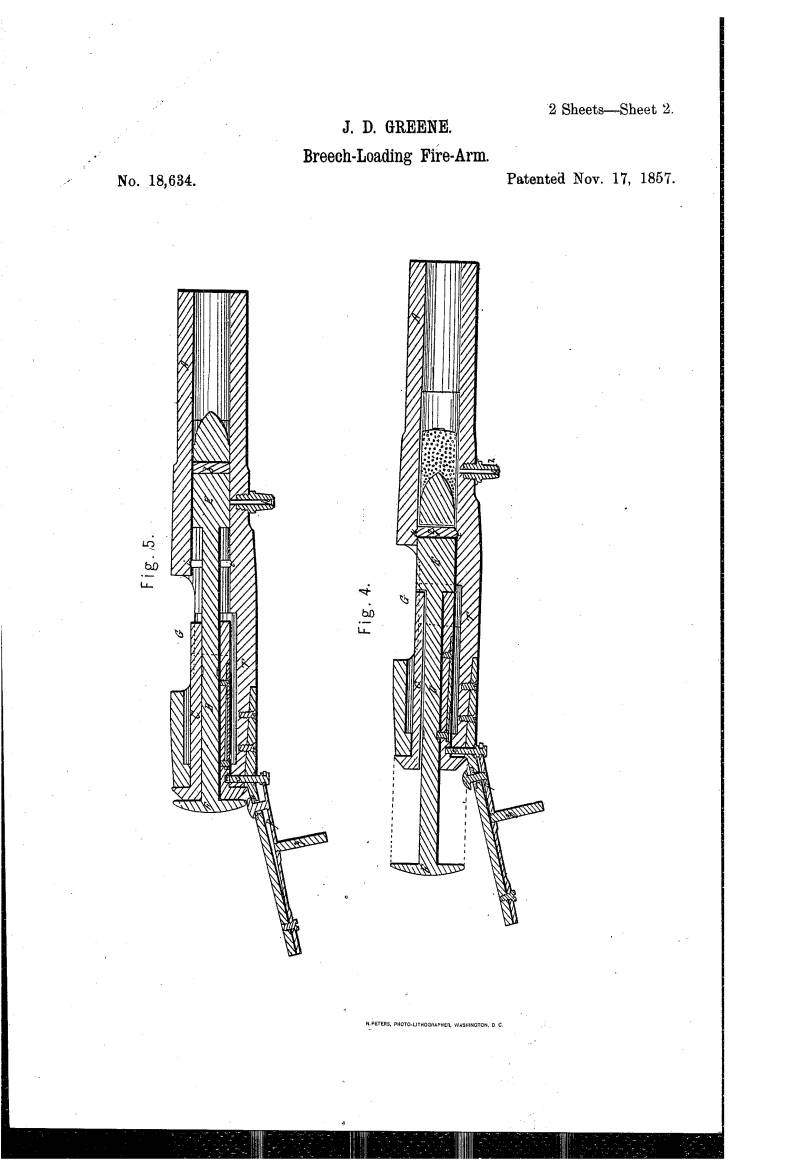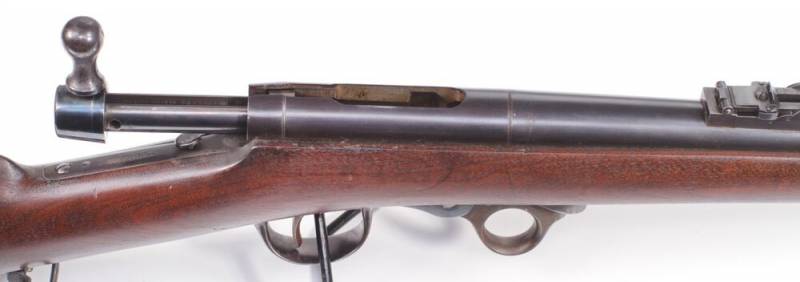Green's rifle: the first among the Russian "breech-loading" ...

Green's rifle. The hammer is cocked. (Institute of Military Technology in Titusville, Florida)
NS Leskov "The Tale of the Tula braid Lefty and the steel flea"
Russian rifle drama. Let's make a reservation right away that actually cleaning weapons and very much attention was paid to its saving in the Russian imperial army. So all Leskov's words about the "brick" are from the realm of fantasy. That is, it could have been, and it probably even happened somewhere, but it was contrary to the charter and in violation of the rules. But the fact that the lag in the field of armaments was obvious is undoubtedly. And today we will finally start publishing a series of articles on how this gap was overcome after the Eastern War. Moreover, VO already had articles (and many!) Devoted to the Mosin rifle and even a bayonet to it. But there was no material about what happened after the six-line primer rifle was adopted in 1856. In 1859, a Cossack rifle was developed, and in 1860, a Cossack rifle entered service - based on the infantry and dragoon models, and ... story muzzle-loading small arms in Russia ended. Our military has finally realized that the time for such weapons has passed, and it is necessary to re-equip the army with rifles that are loaded from the treasury. Where to get them?
A suitable sample was found in the same 1859 in the United States. Suitable in the sense that it met the requirements of our military: it was supposed to be a primer rifle, into which existing muzzle-loading rifles could be converted relatively easily and cheaply. The cartridges for it, as before, should have been glued in the troops, well, and it had to be simple so that our "stupid" soldiers could use it. For some reason, such a judgment existed among our gentlemen officers regarding our "gallant little soldiers". It was said about them that "the soldiers' fingers are too rough", and they will begin to lose the primers for primer guns. When they found out that no, they are not rude, and no one loses the primers, and they put on perfectly - they began to assert that it is difficult to teach an ordinary infantryman to use the rifle scope, which had divisions from 200 to 1200 steps. Therefore, for the infantry rifle, the scope was made only 600 steps, and for the dragoon rifle - 800! And this is after the Crimean War, where, as you know, the French choke Thouvenin showed good aiming accuracy at a distance of up to 1100 m!
Well, now they began to say, they say ... there is nothing more complicated than a primer rifle for our soldier to offer. But let it then, as in the West, be charged from the treasury. Where did we get such a strange distrust of our own soldier, we will not find out now. However, the fact that it was because of him that our supreme military ranks tried to choose weapons, albeit not the best, but the simplest and cheapest, is undoubtedly. However, not only ours. In the United States, after the Civil War, American cavalry received the Springfield single-shot carbine, although the seven-shot Spencer and the 12-shot Winchester already existed. But ... expensive, "the soldiers will not be able to handle this weapon." Well, yes, the cowboys could, but the soldiers, for some reason, cannot. But no one doubted the need for piping, multi-colored uniforms, sultans and brass ammunition!
So the slogan of the day was "simplicity" (which is often worse than theft!) And ... so that the soldiers themselves glue the cartridges. Here, by the way, it should be remembered that on the eve of the war, our soldiers were given 10 rounds a year for practical shooting! And now let's think: how long did it take to glue such a cartridge, fill it with gunpowder and fix a bullet in it? Well, let's say six minutes. So, working continuously, a soldier could make these same 10 rounds in just one hour. And in eight hours - 80! However, this was not the case. That is, there was time to scrub the buttons, but to prepare cartridges to teach the soldier to shoot well - alas, no.
So, as you can see, it was quite difficult to satisfy the tsarist generals then. However, a sample suitable for testing was still found - and not somewhere nearby, but still there in the United States. It was a breech-loaded single-shot rifle developed by US Army Lt. Col. James Durrell Green. The Green Rifle was the first bolt action rifle adopted by the United States Army and used during the North-South Civil War. Moreover, this rifle was well, very original, even unique in its kind! Green patented it on November 17, 1857 with US patent No. 18634, but he got a ready-to-use sample two years later ...
Green's rifle used an unconventional cartridge in which the bullet was placed behind the powder, which made the shooting process unusual. She also had an oval section of the bore according to the Charles Lancaster system. The oval bore of the barrel twisted along the entire length of its barrel, ensuring the rotation of the bullet. She also turned out to be the first small-caliber rifle (13,5 mm) adopted by the US Army, and the only rifle with an oval drill in the US Army.
In May 1862, Captain Thomas Jackson Rodman of the US Department of Arms tested the Green's rifle and ... criticized its design, noting that the location of the capsule from the bottom is inconvenient, since they easily fall off the hose. The bizarre design of Green's patented cartridge also made the rifle difficult to use. But despite the negative reception, the US Department of Arms still signed a contract for the supply of 900 Green rifles at a price of $ 36,96 per piece, which was significantly more expensive than the then muskets.
The rifles were delivered to the Washington arsenal in March 1863, where they remained throughout the American Civil War. In December 1869, they were transferred to the arsenal of New York and remained in storage there, and then sold at auction in 1895 as historical curiosities.
True, about 250 rifles were apparently sold to militias in Massachusetts at the beginning of the Civil War, because the bullets of Green's patented cartridges were then discovered on the battlefield of Antietam - apparently, these rifles were used there. And so this rifle would have remained among the weapon curiosities of the "great rifle drama of the United States" if it was not clear why (or, on the contrary, it was very clear why) had not been paid attention to by the Russian government, which ordered 2100 guns from Green (according to American data - 3000 ) for testing in Russia, and he also received a small contract for 350 rifles from Egypt. Since Green did not have his own manufacturing facilities, the rifle was manufactured by the AH Waters Armory in Millbury, Massachusetts. About 1859 rifles were produced from 1860 to the early 4500s.
So, what kind of weapon was it, since our military liked it so much? Here, its main feature should be noted: Green preoccupied the problem of reliably obturating a traditional paper cartridge and created a rifle that fired his own patented paper cartridges in .53 caliber. These cartridges were unique in that the powder in them was located in front of the bullet, and not behind it. The idea was that when firing, there will be another separate bullet in front of the cartridge - and so it will fly forward, while the rear bullet will expand under the pressure of the powder gases and will act as an obturator.

Green's patron
Due to the non-standard design of the cartridge, both the bolt itself and the order of firing from this rifle were unconventional in this rifle. The shutter was a structure that consisted of two parts: an external shutter and a piston located inside it. The outer bolt was hollow, which allowed the piston to move back and forth along it, with the bolt handle being connected to the piston.

The shutter is open. Top view (Institute of Military Technology in Titusville, Florida)
To fire, it was necessary to press the safety button located behind the bolt, thereby releasing the bolt, then turn it up, take it back and place a bullet without a cartridge in the chamber. Then, without turning the bolt handle, move it forward so that the piston can push the bullet into the chamber until it stops.

The shutter is closed. Top view (Institute of Military Technology in Titusville, Florida)
Then the bolt handle was again retracted, and this time it was necessary to put a cartridge with a bullet into the receiver. Now the piston had to be pushed forward again to place it in the chamber. After that, the shutter was closed by turning the handle to the right.
For a shot, the lower ring trigger had to be cocked halfway, and a primer was put on the cone of the brandtube. Then the hammer had to be cocked completely - finally, it was possible to shoot from the rifle by pressing the trigger. After the shot, the firing process had to be repeated, with the last bullet always remaining in the barrel, and at the same time it was clear that it was there.
As already noted, when the hammer was cocked, the percussion capsule was not held by anything on the hose and could easily fall off from it from the shock.

In Russia, rifles were delivered with a barrel length of 35 inches (87,5 cm) and a total length of 153 cm (without bayonet), and with a bayonet - 198 cm.The rifle weight was 4300 g without a bayonet and 4650 g with a bayonet. The Dragoon version has traditionally been lighter and shorter. In the rifle in the United States, smooth cylindrical bullets were used, and in Russia, cylindrical-conical bullets with three grooves, into which a donkey was stuffed. (Institute of Military Technology in Titusville, Florida)
And what was found out as a result of testing this rifle with us? That the two-bullet barrel locking system does not work well. If the bullet did not expand very much, the gases would still break through, and if it did, then the bullet could not be pushed out of the chamber further into the barrel and had to be driven back out of it with a ramrod. The magnitude of the expansion of the bullet depended on too many variables: the composition of lead, the composition of gunpowder, its amount in the charge, that is, on factors that could not be unified at the level of technology at the time. Although, yes, cartridges for it, as well as bullets, could still be made directly in the troops by the hands of soldiers. As a result, this rifle was never adopted by the Russian army - the first pancake in the field of military cooperation between Russia and the United States in the middle of the XNUMXth century came out lumpy ...
PS The author and the site administration would like to thank the curator of the Institute of Military Technology (Titusville, Florida) Corey Wadrop for permission to use photographs from his article on the TFB website.
PSS Not so long ago I decided to try my luck again at the State Historical Museum (State Historical Museum), asked for permission to use photos from their website as illustrations for my articles on VO. The answer is: the price for a 2nd class photo, that is, not for printing, but in electronic media - 17 rubles per piece! Comments, as they say, are superfluous here! And at the top we have something they say about the patriotic education of our citizens on the glorious examples of history ...
To be continued ...



Information